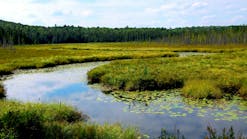Road salt is used practically everywhere, for a simple reason: It gets the job done. But not without consequences.
Sodium chloride was first used as a roadway deicer in 1938, on an experimental basis, in New Hampshire. By the winter of 1941—42, a total of 5,000 tons of salt was spread on highways nationwide, according to the Cary Institute, a not-for-profit environmental research and education organization in Millbrook, NY. Since that time, the use of road salt has expanded massively. Each year, more than 18 million tons of sodium chloride is spread over roadways in the United States from Maine to Texas, from Alaska to Arizona.
And the volume of salt distributed over roadways scales ever higher. It helps that it is relatively inexpensive, and that it can be found pretty close to where it’s needed, with major deposits in the Great Lakes region and production facilities on the central plains and the desert southwest and west coast areas.
Still, according to the Salt Institute, more than 40% of dry salt produced in the US is used for highway deicing. And gradually, this massive annual redistribution of this relatively benign material, otherwise known as table salt, is beginning to show some potentially serious impacts on the environment.
Obviously, we don’t generally consider salt a dangerous substance; we crave it in our diets, and when it’s added to water it dissolves readily and, we assume, disperses quickly, eventually flowing invisibly to the sea, where it easily washes out in comparison to its natural concentration. But what if our assumptions about salt and how it behaves in the environment have not been quite correct?
Studies performed by the US Geological Survey (USGS) and private agencies, such as the Cary Institute, have begun to show that salt applied to treat icy roads may not disperse as easily as once thought. These new studies indicate measurable effects on aquatic life associated with salt concentrations previously considered inconsequential.
Good in Moderation
While direct acute toxicity might be expected at very high chloride concentrations, Stuart Findlay, senior scientist in aquatic ecology at the Cary Institute, says concentrations that do that kind of damage—typically characterized at over 500 milligrams to 1,000 milligrams per liter—are relatively rare and are primarily constrained to areas within a few hundred yards of treated road surfaces.
“That acute exposure is spiky,” says Findlay. “If you get concentrations of 1,000 milligrams per liter, you get direct mortality. That doesn’t happen very often. But what are trickier are the lower concentrations from one hundred to a couple of hundred milligrams per liter. They are much more common.” Findlay says these concentrations may have a long-term impact on aquatic organisms. “It may not kill them in a day, but it does have an effect.”
Chronic chloride exposure at slightly elevated levels, Findlay says, can impair the development of “the small plants and algae that are important food sources; you can have effects that translate up the food chain.” For instance, he says higher organisms “might lose an important food source.”
Aside from the initial acute exposures in the direct vicinity of roadways and chronic toxicity downstream, research has shown a tendency for chloride levels to continue rising over the summer months in receiving waters at considerable distances from roadbeds where deicing chemicals had been applied. These findings, recorded over the past decade or so, suggest that salt does not flush quickly through a watershed, but rather that it migrates gradually through the environment, with probable effects upon surface waters, soils, and aquifers. These effects, Findlay says, have yet to be fully evaluated.
Nonetheless, chloride concentrations in waterways today are much changed from those seen by earlier generations. A total maximum daily load (TMDL) study for the Policy-Porcupine Brook in Salem and Windham, NH, along the I-93 corridor revealed that between July 1, 2006, and June 30, 2007, the chloride concentration averaged 163.02 milligrams Cl/L. By comparison, the report noted typical chloride concentrations in New Hampshire rivers in 1920, before salt was used as a deicer, had averaged a mere 1.3 milligrams Cl/L.
The effects of relatively moderate elevations in chloride levels noted by a recent Cary Institute report include “decreased reproduction in amphibians, plant browning, and lower nutrient availability for plants and animals.” The report continues, “Ecosystem function is compromised before “˜toxic’ levels are reached. In addition, increased salt in streams and lakes can be associated with other indicators of human impacts, such as increased nitrogen, which causes poor conditions for fish and other aquatic animals. Moderate levels of salt in wetlands can increase unwanted invasive species.”
Unsavory Effects
Findlay says that, in addition, there can be a “variety of effects on the soil.” According to the Cary Institute researcher, the sodium component of salt can break off from the chloride and deprive soil of its capacity to absorb and retain noxious compounds that may include metals and toxins. According to Findlay, when sodium ions break free, they can in turn “knock off” the captured toxins or metals sequestered in chemical bonds with other particles in the soil, “releasing them to once again flow with the water,” for a second round of adverse impacts on water quality.
The likelihood of this happening depends on many factors, including soil composition, pH, and others. “There’s a fair amount of subtle chemistry that is hard to get a handle on,” says Findlay.
John Mullaney, a supervisory hydrologist and researcher with the USGS in Connecticut, points out another possible consequence of excessive salt in the environment. He says salt can cause lakes to “stratify more easily than usual.” When this complication occurs, the salty water, with its higher density, sinks to the deepest parts of the lake and stays there, disrupting the cold deep-water ecosystems that provide habitat to many important game fish.
Finally, Findlay notes that although this is not yet a widespread occurrence, salt has become “a worrisome issue for some communities if it reaches the groundwater and ends up in the drinking water.”
According to Mullaney, it’s difficult to attribute salt exposures to any particular incident or source. He says, “It’s difficult to catch events that involve road salt” using most common automated monitoring equipment or practices because they happen too quickly, “over a number of hours,” and leave little trace at the initial site. Furthermore, Mullaney says, there are other sources of chlorides that may contribute to elevated levels, including water softeners, landfills, and sewage plants. Tellingly, however, he says USGS studies have found “a relation between high concentrations of chlorides and road density.”
The Impact Reduction Team
With all of this in mind, Findlay and Mullaney concur with the general view held by water-quality professionals, public service officials, and the lay public: that salt is nonetheless the best chemical agent available to provide safe roadways under freezing conditions.
Connie Fortin is of the same opinion, but she also believes that the way we use salt today for deicing “isn’t sustainable.” As founder of Fortin Consulting, a firm that offers training for operators and symposia on winter maintenance for managers, she wants to do something about it. She represents a growing cadre of specialists who are beginning to spread the word that we can have safe winter weather roads while reducing the impact of salt on the environment.
Her concept is simple. Because, she says, “we don’t have the option of collecting it, it never settles out; reverse osmosis is not practical,” there is only one real solution. “We have to reduce the amount we use.” And Fortin says any effort to reduce volume must rely upon people who will play the key role in keeping roads passable during icy weather: the men and women of winter road safety and maintenance crews.
Getting Workers to Buy In
Fortin says the first practical step in bringing road salt under control is getting workers to buy into the concept. Working closely with the Minnesota Pollution Control Agency, she has developed a specialized training programs designed to spread the word that chloride exposures can be controlled through judicious salt use backed by science and the right equipment.
But Fortin says delivering that message to front-line personnel can occasionally pose a few challenges. Harboring the impression that reducing salt means reducing service, workshop participants have tossed her one question from the outset: “Which would you rather see, dead fish or dead people?”
Fortin says she responds by telling them “We don’t want to see either one.” She says the number one message of her workshops is “We’re not reducing the level of service. What we’re trying to do is integrate science into the tradition of applying salt.” According to Fortin, the widespread road salting practices we generally see today “evolved without much science,” and she is focused on changing that.
From there, Fortin quickly moves beyond academics to the practical, simple, and effective first steps to reducing the amount of salt that gets spread on icy roads the operators are charged with clearing.
Lower Speeds and Lighter Loads
“If you think about integrating science, the first thing you want to do is be aggressive with snow removal,” says Fortin.
Mark Devries, maintenance superintendent for McHenry County, IL, and winter maintenance chair for the American Public Works Association (APWA), shares this view. He says, “The best way to remove it is to plow. We’ve got to get away from the idea that we can melt it.” He says salt should be applied for the primary purpose of making snow and ice easier to plow, by breaking the bond or preventing the bond between ice and pavement.
Beyond promoting that fundamental understanding through the ranks, Fortin says considerable reductions can also be achieved with small changes in perceptions and behavior, and at virtually no cost.
Obviously, reducing speed is the first step towards enhancing safety during foul weather for any driver, particularly on roads where ice might be present. But Fortin says that for operators of winter maintenance equipment, there is an additional reason to go easy. If they drive too fast, they’re just wasting salt.
For instance, Fortin says that for a truck traveling at speeds over 30 miles per hour, the salt coming off the truck’s distribution spreader has enough momentum that, with a couple of bounces, 30% of it simply caroms off the pavement into the drainage ditch at the side of the road, creating an environmental hazard without doing a thing to enhance safety.
Clearly, by moderating their speed, operators can provide a major reduction in how much salt they’ll need to do the job effectively, Fortin says.
Devries says another easy, low-cost reduction in chloride exposure can be achieved by replacing the “more is better” paradigm in the stockyard. According to Devries, this mindset encourages operators to load as much salt onto their trucks as they can, and drivers tend to use what they load, which is often more than is needed. Studies show, however, that if trucks are loaded precisely, 20% less salt is used, providing an instant reduction with a simple change in behavior.
Devries advocates a policy of having management carefully evaluate operations, loading only the precise amount of salt needed on each assigned route. He says the process is part of what is known as “sensible salting,” an approach he tries to promote among winter maintenance teams nationwide.
Sensible Salt
When he conducts training programs with management, Devries often likes to open the discussion by asking managers to imagine that their deicing plan calls for an allocation of 5,000 tons of rock salt. He then asks them to envision what they would do if someone “came in and said you can only have 2,000 tons. That gets the ball rolling,” he says.
Devries offers workshop participants additional low-cost recommendations to reduce salt use. He says adding a little water to salt just prior to distribution can significantly improve efficiency. “When we put dry salt down, we can lose 26%; when we wet it first, we lose only 4%.”
He notes, however, that McHenry County has pulled out all the stops to reduce salt. “Every one of our trucks has a road temperature sensor. We have some of the best equipment you can get. It’s all focused on giving the driver as much information as possible so he can make the right decision.”
Devries believes the necessary skills can be imparted through training and honed through experience. Although it’s only relatively recently that salt has been recognized as a concern, in his 27 years with the agency he has seen some big changes in winter maintenance practices. And by employing salt reduction policies and technologies over the past 10 years, he says, the county has reduced its salt use from 15,000 tons of salt per year “down to 9,000 to 10,000 tons, despite the fact the county has grown and added lane miles and equipment. It’s not just because we used beet juice, or computers; it’s all these things combined—it’s the training.”
A Groundswell for a New Paradigm
Devries has packaged his insights into a one-day course for winter maintenance crews on sensible salting that he has offered to his colleagues across a wide range of agencies in McHenry County.
“We’re pushing certificate training with an emphasis on protecting groundwater,” he says. Although the certification is voluntary, Devries says there’s a strong justification to bringing a new level of professionalism to winter road maintenance. He contrasts the lack of training required for winter operations with the background required to perform some of the other duties of road safety personnel. “If you want to stand on the road with a stop/go-slow paddle, you have to be trained and take a test, but if you want to put plow on your pickup and put sodium chloride on the road, there’s no training and no regulations.”
Although he says there are as yet very few TMDLs for chloride in US waterways, there is a significant prospect of more stringent regulation in the future. And Devries doesn’t see waiting and hoping that doesn’t happen as a viable response “We need to manage ourselves before we get regulated,” he says.
Fortin Consulting offers a certificate program in winter maintenance and chloride reduction through the Minnesota Pollution Control Agency, providing an agency database listing for the certified personnel who have successfully completed the training.
Although sodium chloride is not today considered the most severe of environmental issues affecting waterways, Findlay says, if we were to stop using salt tomorrow chloride levels in receiving waters would continue rising, not reaching their peak for several years. Therefore, he believes now is the time to act to prevent the problem from becoming worse.
Minnesota is already working to comply with a TMDL for chloride impairments to Shingle Creek, mandating reductions of 71% to meet water-quality standards. Meanwhile, several other TMDLs for chloride are under development in the state. Critically, road salt training programs for both public and private facilities are considered key components of activities to remediate the impairments.
Aside from helping to address TMDL requirements, Fortin views chloride reduction as a good place to start to help workers appreciate the role they can play in stewarding the environment in general. “Salt is something they’re familiar with; they use it everyday, they understand how it works.”
Comparing Notes to Solve a Problem
Devries says he would like to see more dialogue between the world of winter maintenance professionals and specialists that deal more broadly with environmental quality. “If you go to a sustainability conference, there’s nobody there talking about winter maintenance,” he notes. “They’re talking about permeable pavers, planters, bioswales—all kinds of stuff—but nobody is saying “˜You know, we plant all this vegetation, but then the next year it gets killed because of the salt.'”
He says workers who deal with road safety and environmental issues often work for separate agencies with divergent responsibilities. “They don’t often talk to one another about their mutual concerns.” But he says the road salt issue beginning to break down that barrier, at least in McHenry County.
According to Devries, “all of the multiple agencies across the spectrum” that deal with water quality and highway safety have bought into salt reduction policy. Furthermore, he says that the coalition seeking a more informed approach to deicing has grown beyond the public sector to include people in the private sector as well. “We’re in our second year, and over 400 people have been trained in McHenry County,” he notes. And that’s a growth trend he’d like to see spread across the whole US.
“We’ve got a lot of things in play,” says Devries.
The APWA launched a new Winter Maintenance Supervisor Certificate Program with “a focus on sustainability and lessening the impact of winter maintenance practices to the environment.” The program, introduced at the North American Snow Conference in Spokane, WA, in April 2011, was tailored to meet the needs of current winter maintenance supervisors, as well as operators who aspire to that role. Devries says the seminar played to a sellout crowd of 220 participants, forcing the organizers to scramble for a larger venue during the weeks leading up to the event.
Many Opportunities
Fortin says she spoke with a recently retired public works director who said he had attended Salt Symposium sessions that Fortin Consulting developed several years ago to address salt issues at the management and policy level. At first, the public works supervisor said, he thought of the whole process as a waste of time. But then, Fortin says, “He tried out some of the practices. They went down from using 450 tons of salt to 350 tons in the last two years.” And he said for the “first time ever” the drivers began to express pride in using less salt—so much so that they now highlight their salt reduction efforts in their employee evaluations.
Fortin says knowledge is the key. “No one had taken the time to explain to them how road salt works scientifically.”
Devries agrees. “When you tell them a cup of salt in five gallons of water kills bluegills, they understand what we’re talking about. Anyone who is over-salting is just trying to do a good job and make the road as safe as they can,” he says.
“If you took a poll of our industry—of people who do this job—you’d find that they are people who love to fish and love to be outdoors; that’s why they chose this job. It’s a big thing to them to keep the road safe, and they buy into the idea to save the environment.”
And Fortin says a scientific approach to road salt can have an equally powerful influence on management. “Once they sit through the training and see all the opportunities there are to fix this, it’s easy to pick one or two to begin working on,” she says.LTAP and Tribal Technical Assistance Program (TTAP) are composed of a network of 58 centers—one in every state, Puerto Rico, and regional centers serving tribal governments. The LTAP/TTAP centers enable local counties, parishes, townships, cities, and towns to improve their roads and bridges by supplying them with a variety of training programs, an information clearinghouse, new and existing technology updates, personalized technical assistance, and newsletters.







